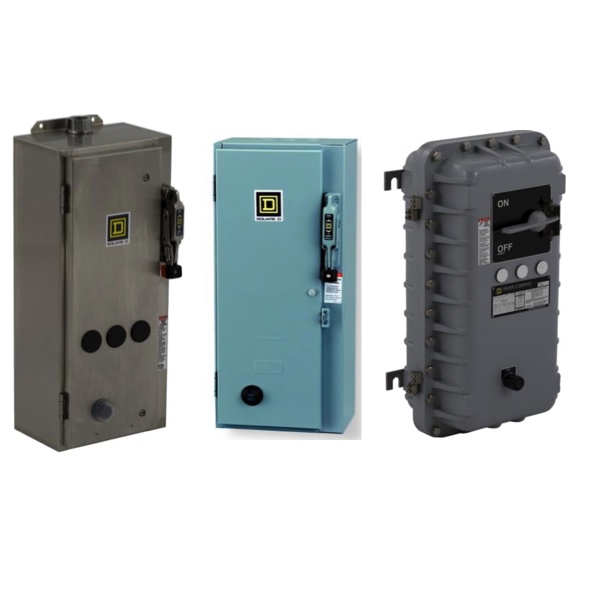NEMA Non-Reversing Combination Starters

Non-reversing combination starters are motor control devices that integrate multiple components into a single enclosure to provide control and protection for electric motors in non-reversing applications. These combination starters offer convenience, compactness, and enhanced functionality in motor control systems.
Non-reversing combination motor starters are designed to control the operation of electric motors. They typically incorporate components such as contactors, overload relays, and other control devices to start, stop, and protect the motor. They include short circuit protection to safeguard the motor and electrical circuits against excessive current caused by a short circuit fault. This protection is usually provided by a circuit breaker or a fuse. They also incorporate overload relays to protect the motor from overcurrent conditions that can occur due to excessive load or motor faults. Overload relays monitor the motor's current and trip the starter to interrupt power if the current exceeds a preset threshold.
More Information about Non-Reversing Combination Starters
NEMA non-reversing combination starters adhere to the guidelines and standards set by the NEMA organization. These standards ensure compatibility, safety, and performance consistency across different manufacturers and applications.
Single Enclosure: Non-reversing combination starters are housed in a single enclosure, which helps to streamline installation and reduce wiring complexity. The integration of various components into one enclosure simplifies the overall motor control system.
NEMA Sizes: Non-reversing combination starters are available in different NEMA sizes, which specify their physical dimensions and motor power rating capabilities. Common NEMA sizes include Size 0, Size 1, Size 2, and so on. The appropriate size is selected based on the motor's power requirements.
Schneider Electric/Square D: Schneider Electric is a reputable manufacturer that produces a range of electrical products, including non-reversing combination starters. Square D is a well-known brand under Schneider Electric that offers motor control and protection solutions, including combination starters.
IEC Standards: Non-reversing combination starters may also adhere to International Electrotechnical Commission (IEC) standards, which provide global guidelines for electrical equipment. IEC-compliant combination starters may have similar functionality but follow different standards compared to NEMA-based starters.
Compact Design: Non-reversing combination starters often feature a compact design, allowing for space-saving installation in various applications. The compact size makes them suitable for installations where space is limited.
Application Flexibility: Non-reversing combination starters support a wide range of motor applications across different industries. They can be used in industrial machinery, pumps, fans, conveyors, compressors, and other equipment that require reliable motor control and protection.
Motor Control Basics
Motor control allows operational control of electrical motors in various environments.
Motor control circuits provide a safe way to operate electrical motors. Back when motor control circuits were in their infancy, it would have been common to see a simple disconnect switch that would be used to turn on and off a motor. Depending on the size of the motor and how much voltage was required, operating this disconnect would have been dangerous, with a very high possibility of arcing or electrocution. Not to mention that when the disconnect was actuated, the large amount of inrush current would have damaged the motor over time.
In today's motor control circuits, there are a few common pieces of hardware.
A circuit breaker is used to protect the motor and any hardware downstream. A contactor and an overload relay are connected together and function in tandem to allow for remote and safe operation of the motor. The contactor functions much like a relay, allowing for a smaller electrical circuit to remotely close the motor contacts, starting the motor. The overload relay is designed to protect the motor in the case of a prolonged overcurrent event. These two devices are wired in series, so that if the overload relay detects an overcurrent event, the contactor will open the motor contacts, shutting off power to the motor.
The other two most common types of motor control hardware are a soft starter and a Variable Frequency Drive (VFD).
Both of these devices function in a similar way to the motor circuit with some added functions. The soft starter is designed to reduce large inrush current to the motor upon startup. This “soft starting” of the motor will prolong its life and allow for safer operation. The VFD performs the soft start functions, but also allows for speed control of the motor. This speed control is critical in many different environments and has made VFDs one of the most common and safe to use motor control circuits today.

